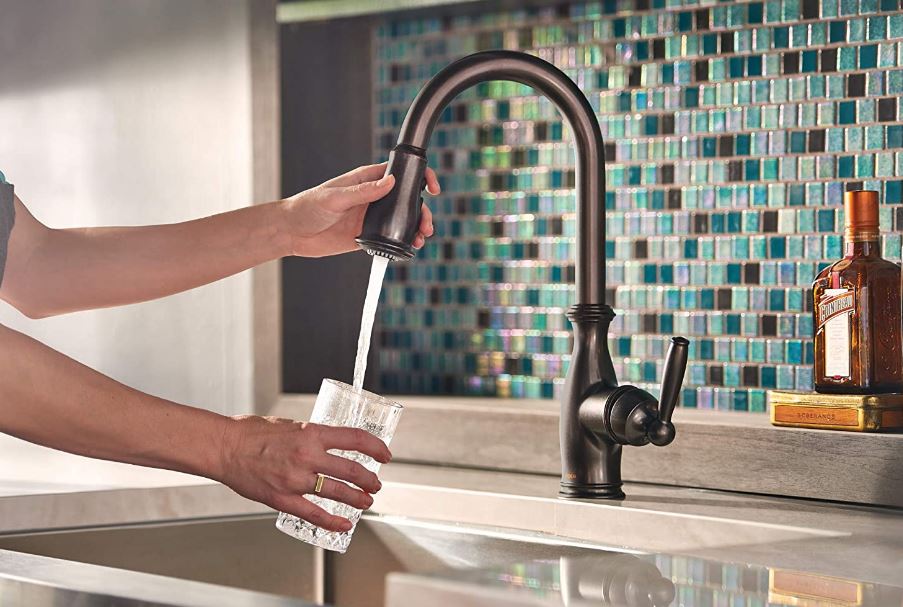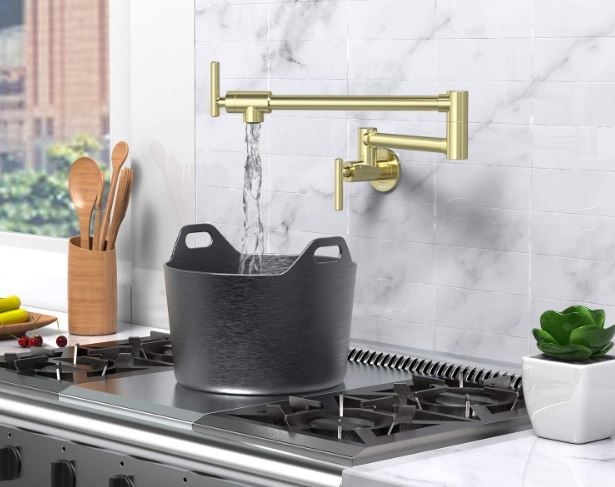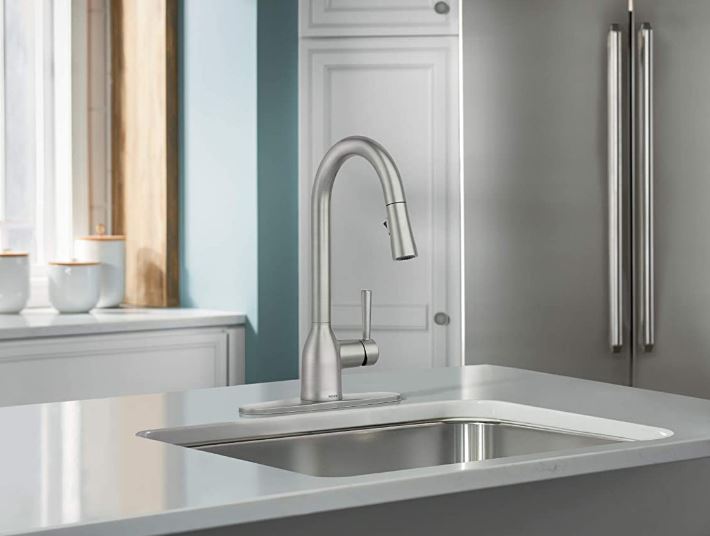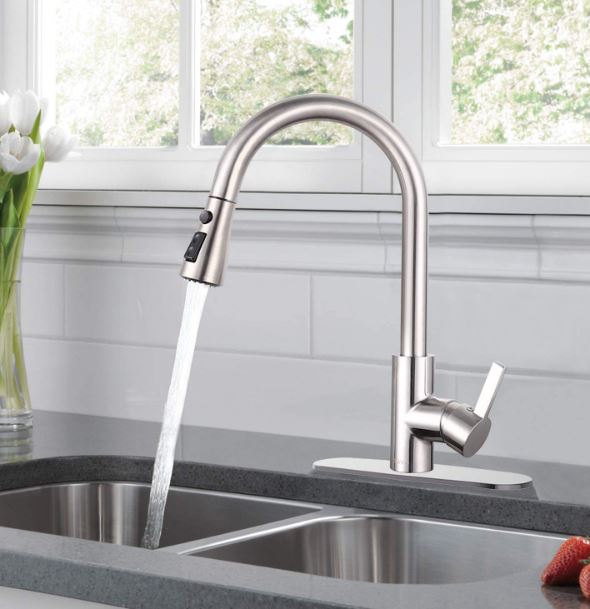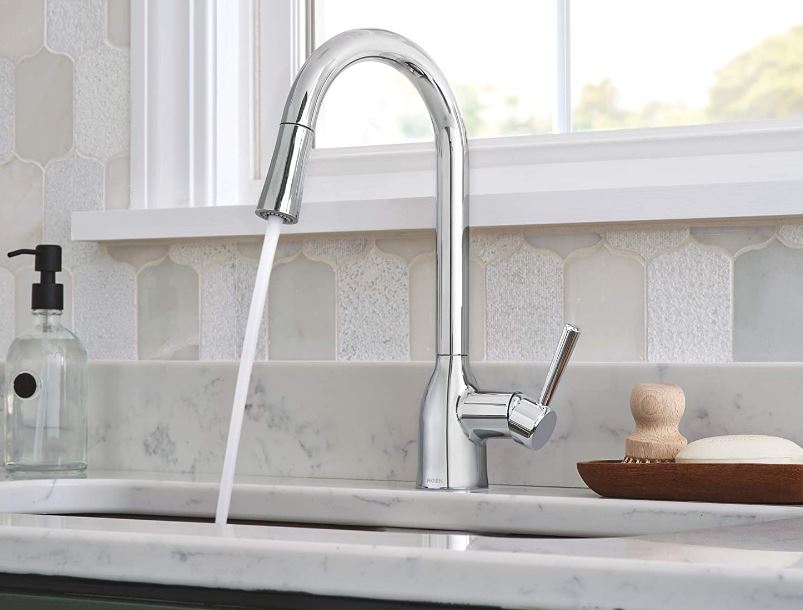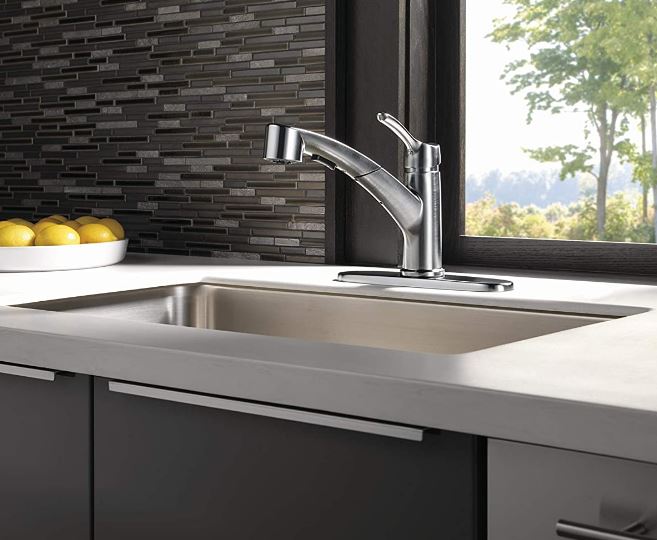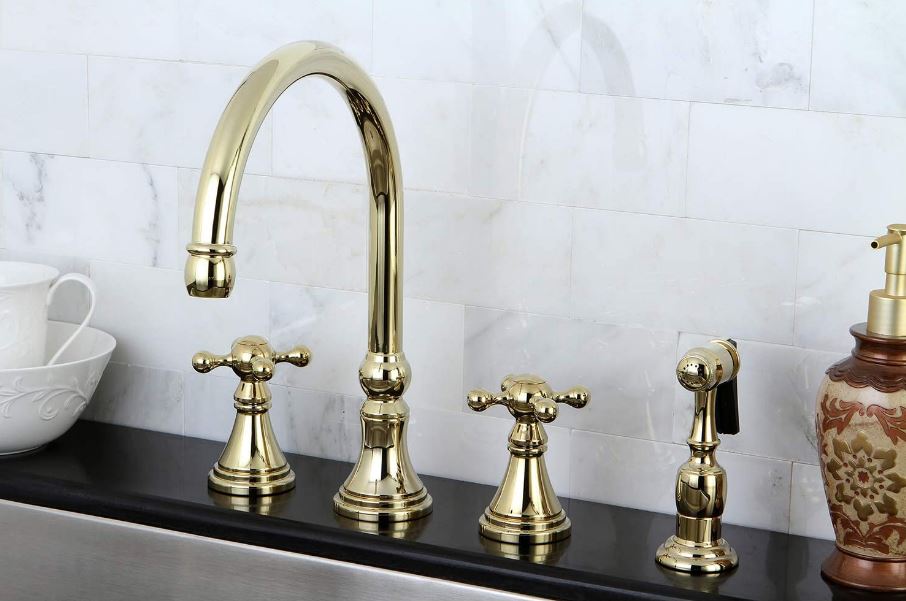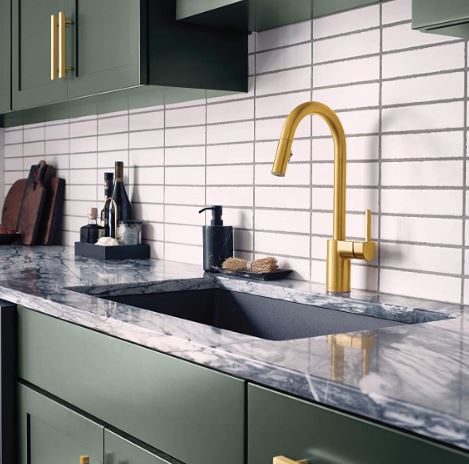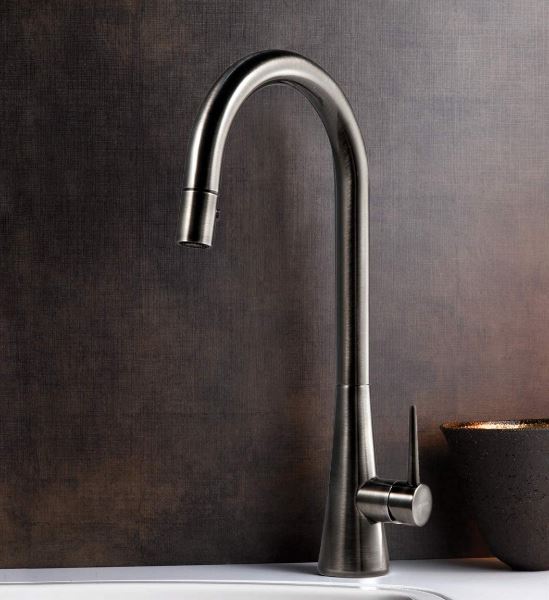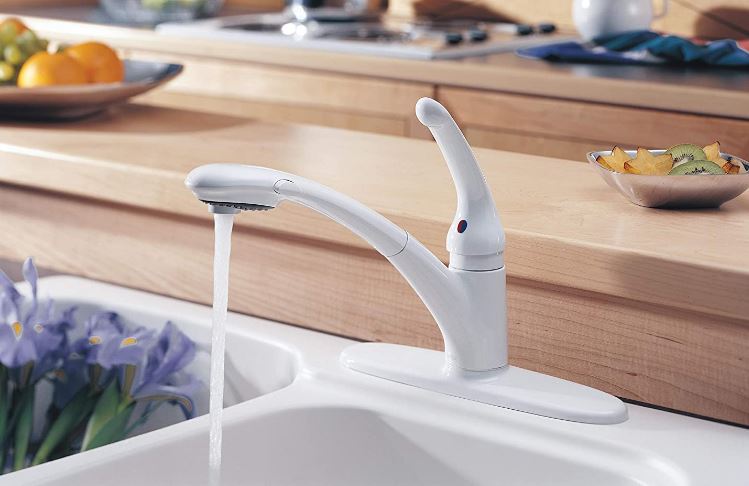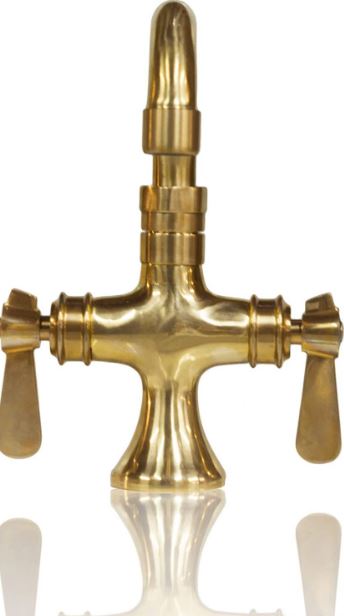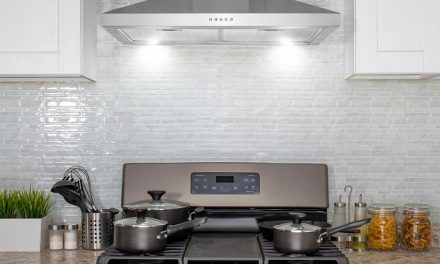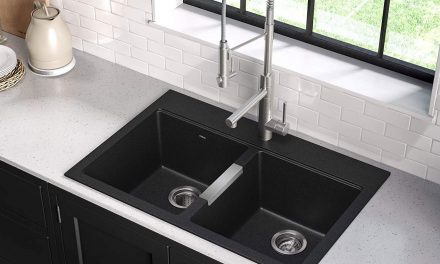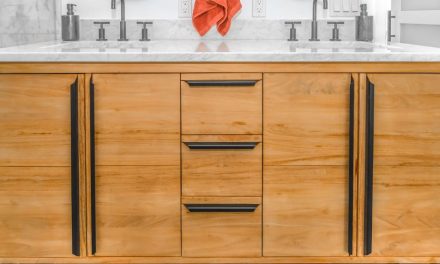What your faucet is made of matters a lot. From the base material, to the finish and finishing method, materials and finishes affect not only the look of your faucet, but also its functionality, long-term appearance, and even safety.
Table of Contents
Types of faucet materials
While faucets can be made of all sorts of materials, by far the most common materials on the market are brass, stainless steel, zinc (and its alloys), and plastic. While the material doesn’t necessarily define the appearance of the faucet, it still affects how the faucet will function.
Keep in mind that most materials can support most finishes. It’s important to read the details of the faucets you’re looking at carefully to see what they’re really made of. You can ask the manufacturer if you’re still not sure. If all else fails, test the weight of the faucet to see if it’s a heavier metal like brass, a lighter one like zinc, or a very light material, like plastic.
Brass faucets
While the bright, yellow-gold appearance of brass isn’t typically homeowners’ first pick for finishes, brass is actually the most popular type of core faucet material.
Brass faucets are typically cast out of H59 or H62 copper (brasses with 59% and 62% copper, respectively). A brass/copper combo is a good material option because it doesn’t corrode under prolonged contact with soft water or calcify under prolonged contact with hard water. It’s also durable and somewhat microbial (from the copper) if left unplated.
The main concern with brass faucets is lead content. Lead is added to brass faucets to make the material more malleable during manufacturing. A certified “lead free” brass faucet can contain up to .25% lead, down significantly from the pre-2014 standard of 8%. This lead content is not generally a problem, though lead can leach out of the faucet into sitting water. It is advised to let new brass faucets run for about a minute before use, especially if they have not been used for a few hours. When it comes to lead content, using cool water is also safer than running hot water.
If you are especially concerned about potential lead exposure, look for manufacturers who certify their faucets as containing no lead whatsoever or consider another material.
Stainless steel faucets
Stainless steel is one of the most versatile materials and finishes available for a faucet. As a finish, it can look plainly pragmatic or crisply modern. And as a core faucet material, it’s a great option if you’re particularly concerned about lead, since these faucets are entirely lead free.
Generally made from 304 stainless steel (iron, chromium, and nickel alloy) or 316 stainless steel (iron, chromium, nickel, and molybdenum alloy), these faucets are corrosion resistant and very durable. They’re also harder than brass faucets, which is great for durability but does make them more difficult to manufacture and more expensive. For this reason, you’re much more likely to see stainless steel finishes than faucets made from actual stainless.
There are two common types of 304 stainless steel used to make faucets, 18/8 and 18/10. These numbers refer to the chromium and nickel contents of the steel. If you’re especially concerned about durability, 18/10 steel (common for silverware) is a bit harder and also takes a slightly better polish. 316 stainless steel is less common, but its added molybdenum content makes it more resistant to acids and salts, so if you’re especially concerned about durability (or live by an ocean) this may be a good option.
Zinc and zinc alloy faucets
Zinc faucets were designed to be cheaper than brass faucets while maintaining brass’s corrosion-resistant qualities. Most zinc faucets are made out of cast ZAMAK, a zinc alloy containing aluminum, magnesium, and copper. Plated zinc and zinc alloy can be indistinguishable from brass.
Zinc and zinc alloy are, however, much less durable than brass. While generally perfectly fine in handles and other parts that don’t take the force of the water, zinc bodied faucets are unlikely to last as long as brass ones. If your main concern is longevity, give this material a miss.
Plastic faucets
Generally found in the cheapest faucets, plastic can be a problematic material. While most plastics used in faucets are corrosion resistant and relatively durable, they still won’t last as long as zinc alloy, let alone brass or stainless steel. One benefit of plastics, though, is that they’re entirely lead free. Of course, plastics and the chemicals used to produce them come with their own downsides.
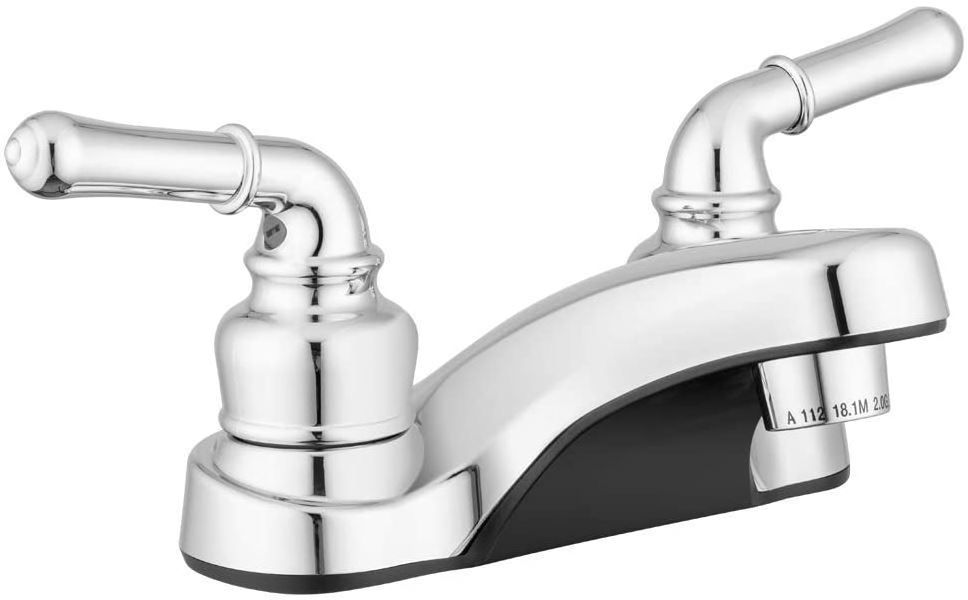
See Pacific Bay’s Lynden bathroom faucet. Though it may look like stainless, this faucet is actually made of ABS plastic, which has then been given a chrome plating.
One type of plastic that is relatively durable is cross-linked polyethylene or PEX, which has been used in the past few years to replace PVC piping in homes. Some moderately priced to higher end metal faucets have a thin inner coating of PEX to avoid any possibility of lead exposure. Full-bodied plastic faucets, however, are not preferred by most experts.
Types of faucet finishes
No matter the material your faucet is made out of, there are a wide variety of finishes available. From matte to metallic, there’s a finish that will suit your needs. It’s important to learn about finishes because often it’s the finish—not the material—that gives you the look you want in your kitchen or bathroom.
Chrome-finished faucets
Consistently popular, a chrome finish is a thin layer of chromium, usually polished to a high shine. Chrome finishes are durable, noncorrosive, and scratch resistant, though keep in mind that the shinier a finish, the more visible minor scratches and blemishes are. Chrome coatings are relatively thin, so they can wear off, but, if care is taken, this finish is likely to last a long time.
Stainless-finished faucets
A stainless finish is generally unplated stainless steel, with all the advantages and disadvantages of that material. Stainless steel, like chrome, is durable and noncorrosive. It can be polished to nearly as high shine as chrome, though it scratches more easily. Unlike chrome, however, a stainless finish, being made of solid metal, can’t wear off. Stainless-look finishes are also available and, like other platings and coatings, may have issues with wear.
Nickel-finished faucets
Bronze and copper are highly prized faucet finishes, and a good bronze or copper finish can really make your faucet a statement piece. These finishes are available in a wide variety of shades from light to dark, as well as textures from polished to brushed to hammered to oil rubbed to suit many different styles. Bronze and copper, like nickel, are fairly soft, so you may want to go for a bronze-look over real bronze. Just make sure that the finish is still metal, not paint, which is a particular concern with oil rubbed bronze and darker shades of copper finish.
Brass-finished faucets
From natural, living finishes to brass-look paint, brass finishes are available in a wide variety of styles and materials. Solid brass faucets have the advantage of not having a coating that can be worn away, and can be lacquered or left to develop a natural patina. Brass-plated faucets may suffer from the same problems as nickel and bronze plating, so brass-look plating may be preferred. Brass finishes can also be achieved with paint, but these tend to be less durable.
Gold, silver, and platinum faucet finishes
These finishes can be the height of luxury or a simple metallic paint, depending on price point and style. Real gold plating is available (and it definitely won’t corrode) but it’s expensive and, depending on method, may wear off. Real silver and platinum coated faucets are extremely rare. Gold, silver, and platinum-look metal plating can be a good compromise between price, durability, and style. These finishes can also be achieved with paint but, like other paint coatings, is likely to chip.
Pewter and zinc faucet finishes
Pewter and zinc finishes are almost never actual pewter or zinc. These finishes are darker than other gray metallic coatings and are generally preferred in brushed or weathered style. Like other metallic coatings, these can either be real metal made to look like pewter or zinc, or a paint or powder coating. Despite being a common faucet material, real zinc is generally too reactive to be used unfinished.
Nonmetallic faucet finishes
Popular nonmetallic finishes like white, black, and biscuit (a creamy white) are readily available in a variety of (mostly matte) styles. Other colors are also available, though they may be harder to find. Nonmetallic finishes are generally painted or powder coated, and so may be more likely to chip or scratch, revealing the material underneath. But these finishes are great for matching any style or blending well with your sink material.
Methods of faucet finishing
It probably doesn’t seem like how your faucet is finished could possibly matter, but it does! The method of finish determines the durability and long-term appearance of your faucet. Here are the most common methods of faucet finishing.
Powder coating
Powder coating is a traditional method of faucet finishing that uses electricity to bind a powdered thermoplastic to the faucet. The plastic powder is then cured with heat to make it set. The resulting coating is harder than paint and more difficult to wear away. Compared to other finishing methods, though, the finish is brittle and can chip easily.
Powder coatings are available in a wide variety of colors and styles and are the best way to get a nonmetallic look on your faucet. Both metals and plastics can be powder coated, and the finish is smooth and matte. A powder coated faucet is resistant to wear from ordinary household cleaners, but harsh scrubbing with steel wool can scratch the coating.
If you’re in the market for the cheapest possible solution, a powder coating is what you should look for in a faucet finish.
Electroplating
Electroplating also uses electricity to bind a coating to a faucet, but this method employs an acidic bath to leave a thin layer of metal on the faucet’s surface. Electroplating leaves a very durable layer of hard metal on the faucet, and chips are much less likely than with powder coating. A variety of metallic finishes can be achieved with this method.
The main problem with electroplating is that thin coats can still be scratched through, leaving a streaky appearance and decreasing the lifespan of your faucet. It can be difficult to tell how thick an electroplated coating is, so make sure to stick with trusted manufacturers if you’re concerned. The electroplating process means some metals can only be attached to certain other metals, so it’s common for multiple layers to be used to achieve certain finishes.
Physical Vapor Deposition (PVD)
Physical vapor deposition or PVD is the newest entry into faucet finishing, though it’s still a tried and true method that’s been used for decades. Basically, high levels of heat and a low pressure vacuum is used to vaporize a piece of metal. This metal vapor then condenses onto the surface of the faucets in a very thin, but very strong layer.
This type of finish is many times more durable than even thick electroplating, and its thinness allows for much finer details on PVD-finished faucets. Every common faucet material, including plastic, can be coated using physical vapor deposition. But only a few metals can be used for the coating. Common PVD coating materials include titanium, zirconium, chromium, and gold. So if a PVD-coated faucet says it’s finished with brass, bronze, or nickel, it’s only talking about the look, not the actual metal.
Generally, PVD finishing is the most expensive finishing method, but it’s probably worth it.
Lacquer and ‘living finishes’
Most popular on natural brass, a lacquer coating is a clear coating that prevents metal from corroding. Lacquer coatings also prevent brass from reacting to acidic stains and keep the color like it was when it was manufactured. This finish will keep its metallic shine, though when lacquer does wear, it tends to wear unevenly, leaving faucets splotty in color.
A living finish is simply unfinished, unlacquered brass. These faucets will acquire a natural patina with time, generally green or brown depending on the specific qualities of your air and water. This finish (or lack of finish) is great for hiding scratches and minor dings. It’s important to keep in mind, though, that unlacquered brass stains and etches easily if acidic substances (like orange juice and tomato sauce) are left on the surface. More minor stains may contribute to the patina of your faucet. Maintenance isn’t too hard with a natural finish (since there’s no coating to wear away) but the occasional polish is definitely important.

